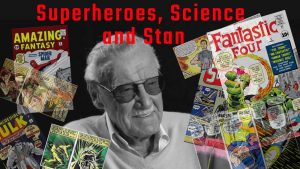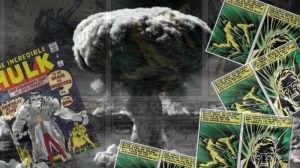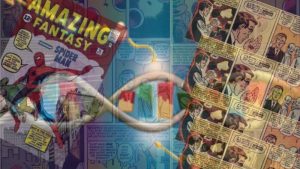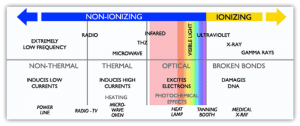Last month saw the sad passing of Marvel Comics legend Stan Lee, who will be remembered by millions of people for his seminal creations of the 1960’s that changed not just superhero comics, but through books, movies and television, the western world-as-a-whole.
 The early Marvel heroes were different to what had gone before, they had problems and real-life concerns. They had something else too, unique to them. Origins that were rooted predominantly in the science of the time. These were heroes of the atomic age and introduced kids across the world to concepts like radioactivity, particles, mutation, cosmic rays and gamma rays. Some of those children would grow up fascinated with those concepts, and science in general.
The early Marvel heroes were different to what had gone before, they had problems and real-life concerns. They had something else too, unique to them. Origins that were rooted predominantly in the science of the time. These were heroes of the atomic age and introduced kids across the world to concepts like radioactivity, particles, mutation, cosmic rays and gamma rays. Some of those children would grow up fascinated with those concepts, and science in general.
Casual fans may be astonished at the sheer number of Marvel characters that had a scientific alter-ego. Reed Richards and his arch-foil Doctor Doom, Bruce Banner, Peter Parker, Tony Stark, Hank Pym… The list goes on. Scientists one and all. All of them granted their powers by innovation gone right or, often gone very wrong.
In a 2013 documentary Lee explained his approach to the origins and abilities of his creations:
“At Marvel, we’re scientific. I wanted Thor to fly, so he has that hammer, I had him swing it around as fast as a propeller. Then he lets go! Now, it’s attached to his wrist, so when the hammer goes shooting off into space, it takes him with it! That’s how he flies. Incontrovertible scientific fact! And that’s the difference between us and the competition.”
Of course, Lee himself would admit that the scientific concepts introduced in Marvel’s comic output could hardly be labelled accurate or well-researched. They likely got more wrong than they got right, but the fact that these concepts were just there in these bright, exciting tales, made them less-alien to children.
The atomic age and the second wave of superheroes
Superheroes had existed before Stan Lee created the Fantastic Four in 1961, in fact, a whole age of colourful caped characters had prospered and faded during and after the Second World War.
Heroes at DC Comics like the Flash, Green Lantern and Hawkman had enjoyed brief popularity before falling out of favour leaving only perennial favourites Superman, Batman and Wonder Woman in publication. Like DC, Marvel, called Timely at that point, had seen heroes like the Sub-Mariner, Captain America and the Human Torch come and go.
It is likely that people were simply tired of battling after the Second-World-War. Most super-heroes had been introduced as Nazi-bashers and now lacked a clear-foe. There was also the fact that the detonation of the atomic bomb had made even the most powerful hero’s ability seem… quaint in comparison.
Lee and Marvel can’t take the credit for kick-starting the so-called silver-age of comics in the 1960’s. Their rivals DC take that honour for re-introducing the Flash in a 1956 issue of the anthology comic Showcase. The reinvigorated scarlet speedster ushered in a second boom in the superhero genre, which Marvel would take full advantage of. These new heroes would be symbols of the atomic power that signalled the end of the golden age of comic book heroes.
The Incredible Hulk: An atomic nightmare
Perhaps the closest analogy that can be drawn between Lee’s creations and the unbridled and terrifying power of the atomic bomb was the Incredible Hulk, introduced in 1962 in the Incredible Hulk issue 1.
Lee would compare his and Jack Kirby’s creation to the plight of the titular character in Robert Louis Stevenson’s Doctor Jekyll and Mr Hyde and cite influence from Mary Shelley’s Frankenstein. The message of these three tales is clear, we should beware the hubris of man and the dangers of the limits of science.

Robert Bruce Banner would become the Hulk after being caught in the blast of a gamma bomb of his own creation. His story is the closest in the Marvel silver-age to a cautionary tale. Though granted with extraordinary powers, Banner was deprived of all control. Much like those behind the creation of the atomic bomb.
The tale is also the closest to other science fiction at the time, which empathised the dangers of atomic power rather than its benefits. In hindsight, after seeing the devastation of Nagasaki and Hiroshima we should hardly be surprised at the fear and trepidation atomic power inspired.
Of course, Banner’s innovation was only an atomic bomb of sorts. It was powered by the mysterious sounding ‘gamma rays’. The mere mention of which likely lead to many a young-mind awakening during a physics class.
Gamma rays were first discovered in 1900 by French chemist Paul Villard and named three years later by Ernest Rutherford. Villard discovered them whilst observing radiation emitted by radium.
Gamma rays are the most energetic form of electromagnetic radiation and as such are, unsurprisingly, incredibly dangerous to human beings. They are created by naturally occurring elements undergoing gamma decay and when cosmic rays (more of which later) strike particles in the upper atmosphere.
We have also observed gamma-ray bursts from space, the most intense of these have produced up to 1044 Joules, the total energy output the Sun will produce in its entire lifetime, in just 10–20 seconds. Such events can be seen from Earth from 10 billion light years away, the edge of the observable universe.
They are not green. Or grey…
The Fantastic Four: Bathed in cosmic rays
Stan Lee and Jack Kirby followed DC’s Justice League title with Marvel’s first group book the Fantastic Four. Like the League, a collection of heroes with radically different powers. The difference between the Justice League and the Fantastic Four was that whereas the former were separate heroes with their own publication history, the Fantastic Four had a common origin and would not appear outside their book.
That origin was based in an actual scientific concept of the time: cosmic rays.

Cosmic rays, discovered in 1912 but not receiving that name until 1930, had been used to give superheroes and fantasy characters strange powers and abilities before, but Reed Richards and his crew encountered them on a space mission, a more likely setting to find this form of radiation. Cosmic rays and radiation, in general, was a major concern in early space missions and to astronauts in general.
Despite what Reed says when explaining them to Ben Grimm, ‘cosmic ray’ is the general term for high-energy particles that emanate from not just outside the solar system, but also from other galaxies. Rather than being comprised of electromagnetic radiation as Reed suggests, the term describes fragments of heavy particles like electrons, protons and atomic nuclei, with tremendous energies and travelling at near the speed of light. When these particles strike the Earth’s atmosphere, they cause a shower of secondary particles which rain down to the planet’s surface.
Likely Stan Lee and Jack Kirby’s inspiration for intrepid adventurers bathed in cosmic rays came from the threat posed to real-life astronauts and their electronics by high-energy radiation. Cosmic rays still cause damage to satellites and machinery operating outside the safety of Earth’s magnetosphere.
Supernovas have long been suspected of being the primary source of cosmic rays, but researchers still aren’t quite sure how they are produced in the quantity that we observe them. Part of the problem in tracing the origin of cosmic rays lies in the fact that their path to Earth is altered by interactions with a multitude of magnetic fields, including Earth’s own.
Despite some mystery about their origins, scientists are finding fascinating ways to use cosmic rays. Only last year a team of researchers used cosmic rays to probe the interior of the Great Pyramid of Giza, discovering a previously unknown chamber beneath the 4,500-year-old structure.
Reed Richards, Marvel’s foremost scientific mind, would be proud.
Spider-Man: Listen bud, he’s got radioactive blood
Undoubtedly, the most recognisable creation of Stan Lee’s came about when he worked in conjunction with Steve Ditko to create the Amazing Spider-man in 1961. Telling the story of a high-school science student exposed to the bite of a radioactive spider at a science-expo, Amazing Fantasy issue 15 was similar in many ways to the lurid sci-fi of the day.

The difference was that Parker, rather than mutating into some terrible human-spider hybrid and allowing the baser elements of his nature to dominate, was granted amazing abilities which, after a terrible decision leading to tragedy, he would use to help others.
Spider-man is now the highest selling children’s character in the world, vastly over-taking his superhero rivals Superman and Batman. Part of his appeal is the fact that the nerdy, bullied Parker could have been any of us. This isn’t an alien from some distant star-system or a billionaire orphan. He is one of us. We identify with Spider-man.
Of course, in the real world, radioactivity works vastly differently than presented in Amazing Fantasy 15, but its dangers are vastly exaggerated. We aren’t ever told in early Spider-man comics exactly what irradiated the unfortunate arachnid that bit Parker but let us assume it was ionising radiation.
Media outlets across the World warn about the dangers of ‘radiation’ with little understanding of what radiation actually is or that there are two distinct types of radiation when to comes to considering the effects on human (or spider) tissues. Ionising radiation and non-ionising radiation.

High-frequency radiation carries with it, considerable amounts of energy. The higher the frequency, the higher the energy. Thus, Dr Banner’s gamma rays, the highest energy electromagnetic radiation is also the highest frequency radiation. Electromagnetic radiation like this and x-rays, far in the ultraviolet spectrum carry enough energy to rip electrons from the atoms in our bodies.
This process, known as ionisation, changes the way these atoms interact as chemical processes redetermined by the surface or valence electrons. This can lead to cell mutation which in turn can lead to unregulated cell growth and cancers.
But mobile phone radiation, microwave radiation, radio waves and other forms of ‘ultra-violet’ radiation don’t carry enough energy to strip electrons from atoms. The unusual thing about this is it simply doesn’t matter how much non-ionising radiation an atom is exposed to, it will not release an electron until a photon of the required energy falls upon it.
It’s almost like a bucket with a ball in it, except the ball with not spill out no matter how much water is poured into it unless that water is the right temperature. It’s an extraordinary result that flies in the face of common sense, one that was revolutionary enough to earn Einstein his Nobel prize.
Still, he was not the genius who thought to irradiate a teenager via an arachnid.
Mutants, pacemakers and particles
Perhaps the hardest part of writing any kind of tribute to Stan Lee is deciding what parts not to focus on. Few creators were so ambitious and created during a short period so many characters that have stood the test of time.
So many of these drew on scientific achievements and emerging scientific knowledge of the time.
Lee’s X-Men used the idea of natural selection to consider how the world would react to the next stage in human evolution, all be it in a wonderfully lurid sci-fi style. Lee, predicted that these individuals would be outcasts, shunned. He also predicted that some of them would consider themselves superior and attempt to enslave the human race.
As such, Lee created a tale that looked at discrimination in a two-dimensional way with a small group of teenagers who never asked or wanted to be different stood between a rock and a hard lace defending a world that feared them.
As such it should escape us that Lee and Marvel likely exposed many children to evolution before it was taught in their high-school.
Tony Stark was indeed a billionaire playboy in a suit of armour whose visage could have easily been mistaken for a swashbuckling hero of times gone by. But under that metal-chest-plate Stark used the technology he had created to keep him alive.
Marvel Comics writer Gerry Conway recalls: “Here you have this character, who on the outside is invulnerable, I mean, just can’t be touched, but inside is a wounded figure. Stan made it very much an in-your-face wound, you know, his heart was broken, you know, literally broken.”
The real science behind Stark’s armour could be compared to a pacemaker which uses an electrical current to keep a heart beating in a steady rhythm. Even though the device in Stark’s chest was an electromagnet which kept shrapnel from passing into Stark’s heart is a dramatic example, the idea of relying on technological implants to simply survive is no longer a strange concept.
Stan Lee was not a great science tutor and to cite him as a scientific influence is a step too far, but I can’t help but recall my early brushes with science in the classroom and compare it to the science I encountered in the twenty-two page, three colour periodicals of Marvel and consider which one influenced my love of the subject more.
Science lessons may have been the meat and potatoes, but comic books were the seasoning.
To echo the timeless phase of that silver-age period.
Make mine Marvel.
Cover image provided by courtesy of the Superheroes in Science Project Malta: http://superheroscience.info/
